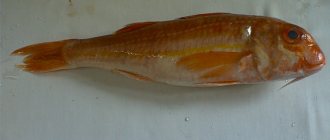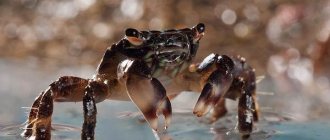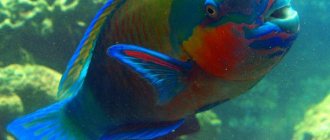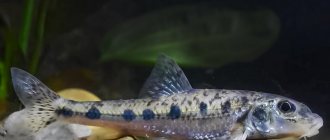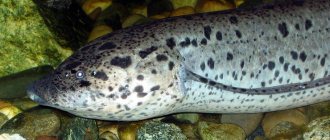Shorts FIFTY Vigorous
873 ₽ More details
FIFTY shorts
2039 ₽ More details
T-shirts FIFTY
There are many organisms living in the oceanic environment. The greatest species diversity is observed among ocean fish: there are peace-loving herbivores that live in schools, and bloodthirsty predators that can threaten all living things. There are both very large and extremely small individuals, but they are all interesting in their own way.
The underwater world of the ocean is filled with a huge variety of species
Fish of the Red Sea. Kingdom of diversity
Over millions of years of existence, the ancient sea is filled with underwater inhabitants in huge quantities. One and a half thousand fish have been studied and described by humans, but this is less than half of the inhabitants of the mysterious body of water.
Not a single river flows into the warm sea. This factor contributes to the preservation of clean water and the development of a special living world. The fish of the Red Sea are unique. Many species are not found in other bodies of water.
Popular and safe fish
A visit by tourists to popular resorts is not complete without scuba diving and sea fishing. Famous representatives of the water depths will leave a vivid impression:
Parrot fish
The name corresponds to its bright appearance: multi-colored coloring and a growth on the forehead like a bird’s beak. Blue-green, yellow, orange-red in color, large fish (up to 50 cm in length) are safe.
But an accidental bite from the powerful jaws can be quite painful. At night, the fish forms a jelly-like cocoon - protection from parasites and predators. Even the hypersensitive moray eel cannot find it by smell.
Fish-Napoleon
The growth on the head, similar to the emperor’s cocked hat, gave the species its name. The impressive size of the Maori wrasse (up to 2 meters long) is combined with a good nature and trusting character. The fish is so sociable that it itself swims up to the drivers to get to know each other better.
Napoleon fish is often called sponge fish
Antais
A schooling fish of very small size (7-15 cm). The inhabitants of coral reefs have bright colors of orange, green, and red. Up to 500 fish can gather in a school.
Bistriped amphiprion
The bright, unusual coloring with stripes outlined in black on an orange background attracts photographers. The fish live in pairs in sea anemones and are not at all afraid of scuba divers.
The tentacles of sea anemones, which are poisonous to others, do not harm the settlers, covered with protective mucus, as if protecting them. Amphiprions are sometimes called clowns. They behave bravely near their shelter.
Clown fish seek protection in sea anemones, which are poisonous to other aquatic life.
Butterfly fish
The beauty is easy to recognize by its tall, strongly flattened oval body with a long dorsal fin and bright black and yellow color. Due to their diurnal lifestyle at shallow depths, they have been well studied by masked divers.
They live with small flocks and pairs. There are color options of blue-orange, black-silver, red-yellow.
Black-spotted Grunt
For her wide lips she is nicknamed sweetlip. The names of the fish of the Red Sea are often telling, so the color of the fish and the grinding sound when biting through the coral determined the name of the inhabitant.
Lethrina
Inhabitants of the sea coastline. They feel great among rocks, reefs, rich in vegetation. Greenish-brown in color with dark spots on the sides. The fins and interorbital space are red-pink. Body length up to 50 cm.
Imperial angel
It’s hard not to notice the fish even among other beauties of the warm sea. Decorated with frontal and ocular stripes. Color from yellow-blue-white range in variations of shades and patterns. A variety of solid and interrupted stripes, spots, specks, transitions and mergers.
The directions of the pattern are also varied: circular, diagonal, vertical, transverse, wavy. Despite all the individuality of the fish's outfits, they are recognizable in their grace.
The imperial angel has a variety of colors
Plataxes
Young sickle-shaped fish grow up to 70 cm in length. The body is flattened on the sides. The color is bright orange or yellow with three black stripes. Curious by nature, not shy, they swim quite close to the drivers. Stay in groups. With age, the color becomes uniformly silvery as the stripes blur. The size of the fins decreases.
Lantern fish
The luminous organs most often are the eyes. The emission of greenish light comes from the lower eyelid, sometimes from the tail or abdominal part. Small fish, up to 11 cm, live in caves at depths of up to 25 m. They hide from divers. Light attracts prey to them and serves as a contact for their species.
Marine herbivores
Zebrafish fish has an interesting beautiful color. The part of the snout from the mouth to the eyes is decorated with small black patterns resembling freckles. From the eye to the caudal fin there is a black stripe, which is divided into two in the middle and combined again. The caudal fin is yellow but has a black edge.
There is a yellow stripe along the edge of the lateral fins, and a black stripe along the dorsal and ventral fins. The body is colored a pleasant shade of blue. This fish is quite small and is used in aquarium keeping, as it can be kept at home. In nature it is found both in small groups and alone.
The fish is peaceful and curious, constantly exploring the reef bottom in search of algae, and behaves in the same way in the aquarium. Prefers places with bright light, as this guarantees the growth of cyanobacteria.
The clown fish lives on a poisonous plant, escapes from predators and takes care of clean water around its savior.
The clown fish lives in symbiosis with anemones - poisonous sea anemones. The body has an interesting color: on a bright orange background there are three white stripes, the transition parts are black. The fish are immune to the poisonous secretions of anemones. In nature, they hide in them from predators. When the school is not threatened, the fish swim actively and increase the flow of water, which brings food to the sea anemones. The fish is small, only 10-18 centimeters in length.
The pajama wrasse is a very fastidious fish with interesting colors. An aggressive attitude towards relatives from the same family is normal for her. He loves to terrorize his neighbors, harming them psychologically and physically. It feeds on algae and gets along well in a marine aquarium. They should be placed in a spacious container, where there is both free space for swimming and shelter. You can feed it with plant foods.
https://youtube.com/watch?v=AZaRQGj9bKE
Poisonous fish
Surgeon fish
The tail fins have sharp spines for protection. In the normal state they are hidden in special recesses. When danger arises, the spikes move apart like cutting scalpels.
The length of the surgeon fish reaches 1 meter. An attempt to pet a bright beauty, blue, pink-brown or lemon, can result in a retaliatory strike and a deep wound.
Stone fish
The deceit lies in the inconspicuous appearance. Warty growths and gray coloring give a repulsive appearance. Buried in the seabed, stone fish blend in with the surface in color and shape. An unexpected prick from the spines of the dorsal fin is so dangerous that without medical help a person dies within a few hours.
Excruciating pain, clouding of consciousness, vascular disorders, and irregular heart rhythms follow after a poisonous lesion. Treatment is possible, but it is difficult and long.
Stone fish perfectly camouflages itself as the seabed
Lionfish or zebra fish
It is notable for its exotic-looking ribbon-shaped fins with poisonous spines. Infection with thorns causes a convulsive reaction, loss of consciousness, and respiratory spasms. Brownish-red scales with alternating stripes resemble a fan. Many marine inhabitants keep a wary distance from the zebra.
There is a strong poison on the edges of the lionfish's fins.
Stingrays (electric and stingray)
Despite their strong damaging effect, stingrays are not aggressive. Careless handling of occupants may result in
- to an electrical discharge, which can result in paralysis or cardiac arrest;
- pricked by a poisonous thorn - the wound is very painful and difficult to heal.
No deaths have been recorded after encountering a stingray, but no one wants to step on a stingray.
Sea Dragon
By appearance, the inhabitant can be confused with the famous bull. But dark spots and stripes reveal one of the most unpredictable predators. It hunts prey both at depths of up to 20 m and in shallow coastal waters. There have been cases when people simply stepped on a dragon buried in the sand.
An inconspicuous fish, up to 50 cm long with an elongated body, attacks with lightning speed. The eyes are set high - this helps in hunting. The spread fan of the dorsal fin is a warning, but it is not always noticed. All needles are toxic. Additional spines are located on the gill covers.
Even dead fish can poison with a poisonous injection within 2-3 hours. Therefore, it poses a particular danger to fishermen. In a fish caught with a fishing rod, the spines are pressed down, but in the hands it will show its cunning. As a result of the poisonous injection, edema and paralysis develop, and there is a risk of death due to heart failure.
Arotron stellate
Large fish, growing up to 1.5 m, can be invisible in the water surface due to their small dot color and slow movement. The main feature is the ability to inflate into a ball.
This is facilitated by a special chamber near the stomach, where water is collected at the moment of danger. Skin without scales is elastic. The bloated appearance scares off enemies.
The poison tetradotoxin accumulates in the body of the arotron, so consumption is not recommended. The bites are painful. Durable tooth plates grind shellfish and coral.
Poisonous fish of the Red Sea often surpass the paralyzing effects of terrestrial reptiles.
Settling sea fish in an aquarium
In order for marine life to take root at home, you need to follow some rules:
- compatibility of species - division by feeding, size, behavior, speed of movement;
- even in small containers there should be a good filtration system, and the aquarium must be cleaned frequently - food settles to the bottom of the container, provoking the growth of algae;
- small fish are easy to care for, but if they are placed in an aquarium, you need to think about it in advance - predators cannot be placed together with calm species.
For the settlement of large species of fish, the following conditions are needed:
- capacity of more than 300 liters;
- timely cleaning of the aquarium from waste;
- settlement of schooling fish species;
- you need to take into account the mobility, diet, toxicity of fish for marine aquariums;
- It is better not to buy large fish without consulting a specialist, since they require special care and other conditions.
Dangerous fish
Needlefish
The body of a narrow hexagonal shape is elongated up to 1 meter in length. The color varies from light green, gray to reddish-brown. With its long jaws, the fish can easily bite through a human body. Meeting her is dangerous.
Tiger shark
The cunning of the species is the unpredictable appearance of man-eating fish in the port, on the beach area, in the bay. Large predators, from two to seven meters long, are decorated with tiger stripes on the sides. The color on a gray background disappears with age. The peculiarity of sharks is their ability to hunt even in complete darkness.
The tiger shark is one of the first places in attacks on people
Barracuda
In appearance it resembles a river pike with small scales, up to 2 meters long. The barracuda's large mouth with knife-like teeth grabs prey tightly and can cripple a person's limbs, mistaking them for fish in muddy water.
It does not show aggression towards humans, but hunts together with sharks, which creates an additional threat. Connoisseurs classify certain types of barracuda as edible fish with valuable meat.
The risk of eating the “unknown” barracuda delicacy is severe poisoning with many symptoms, which complicates diagnosis. Disruption of the body systems: respiratory, nervous, circulatory - leads to death.
Moray
Varieties can be from 15 cm to 3 m long. The serpentine body without scales gracefully moves at the very bottom among stones and crevices. The dorsal fin extends from the head to the tail.
The color is varied. There are individuals both plain and spotted, striped in yellowish-gray tones. A huge mouth of a moray eel with two jaws. After an attack, the teeth of a moray eel can only be unclenched with outside help. A torn bite does not heal for a long time, although the fish is not poisonous.
Bluefin ballistode
It is especially dangerous in the summer months, when nesting season begins. A meeting with a person will certainly end in an attack by a predator. At other times, the ballistod is calm and does not react to large objects. Stays near coral reefs.
The color is spotted or striped, with bright streaks on a dark greenish background. Powerful teeth, up to 7 cm in size, split the shells of crustaceans and grind limestones. The bites are not poisonous, but the wounds inflicted are always very severe. The fish is considered unpredictable and one of the most dangerous on the reefs.
Spotted flathead (crocodile fish)
Favorite habitats are in coral reefs. The size of the fish reaches 70-90 cm. The large head with a wide mouth gives it a resemblance to a crocodile. The body is covered with sandy or dirty green scales.
It swims little, mostly buries itself in the bottom sand and remains motionless for several hours. With sudden jerks he catches unwary fish. The mouth is small, so it hunts only small prey.
The flathead is a fearsome species, covered with spines that protect it from other predators. When meeting a person, he does not show aggression. Spotted flathead should not be touched. The danger is in causing accidental wounds from the dirty spines of a bottom-dwelling crocodile. They lead to inflammation if the affected area is not thoroughly treated.
Red Sea Tylosur
The predator can be seen at shallow depths while hunting for small fish. Large individuals, up to 1.5 meters, are similar to barracudas, but their jaws are longer. A special feature of tylosurs is the ability to jump out of the water and, bending, fly over the waves for a considerable distance.
With their tail they seem to push off the water, accelerating to jump into a school of fish that cannot see the hunter. Fishermen have often become victims when they fall under the toothy snout of a powerful tylosur.
Dangerous fish in the Red Sea have not been fully studied. The unique qualities of the inhabitants, who have survived in the natural reserve for millions of years, fascinate with the diversity and unpredictability of their manifestations. The richness of the underwater world continues to amaze tourists and researchers with its evolutionary beauty.
Predators of the sea
Among ocean fish, sharks are far from the only predators. There are many other aggressive representatives.
Moray eel likes to hide. To do this, she uses caves, coral reefs and thickets of vegetation. The body is quite elongated; with a length of three meters, its thickness is only 30 centimeters. It has a strong jaw, which it actively uses when hunting. Easily camouflaged and attacks from ambush, holds prey tightly with its mouth, uses its tail to hold or tear the victim. With poor eyesight, he has an excellent sense of smell.
One of the dangerous sea predators is the moray eel, which tears its prey with its long tail.
Barracudas are somewhat similar to giant three-meter pikes. They are dangerous to human health and can bite off limbs and cause other injuries. They attack suddenly and indiscriminately, including eating poisonous food. Because of this, their meat is toxic and is not used in gastronomy.
The swordfish is larger in size than many sharks - three meters long and almost half a ton of mass. The most dangerous part of the body is the long bone growth on the upper jaw.
Because of its resemblance to a sword, the fish got its name. Thanks to the four-ton impact force, the swordtail is capable of breaking through an oak board half a meter thick. The predator has no scales.
The danger of this fish is the growth on the upper jaw that resembles a sword.
The European fishing rod is also called the devil. This is due to its extremely unattractive appearance. Its wide mouth is shaped like a crescent moon, its lower jaw is extended, and its eyes are located close to the middle of its head. On the long fin above the upper jaw, bacteria actively multiply and attract fish. If the bait does not work, the anglerfish can rise up and swallow whole a bird that has landed on the surface of the water.
Tuna is a predator that prefers to gather in schools. Its four-meter body can weigh half a ton, but the fish can swim at a speed of 90 kilometers per hour. Tuna is actively used in gastronomy; the French even call it sea veal.
Pelamida also has a silver color, but is much smaller in size. It is no longer than 85 centimeters and weighs no more than 7 kilograms. There are faint stripes on the back that have a blue tint. The fish gather in schools and hunt for sardines and anchovies.

